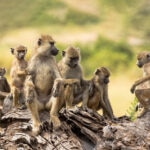The three award-winning scientists “have expanded knowledge of the evolutionary importance of behavior as a driver of animal survival, reproduction and adaptation,” and have demonstrated the need to incorporate social interactions into species conservation plans, according to the committee of the BBVA Foundation Frontiers of Knowledge Award in the Ecology and Conservation Biology category.

The research by Susan Alberts, Jeanne Altmann and Marlene Zuk allows us “achieve a perfect X-ray of the health and physiological state of individuals within a species that is potentially at risk of extinction,” explains Pedro Jordano, CSIC Research Professor at the Doñana Biological Station. This information, adds the Award Committee Secretary, is a vital input “to optimize the selection of individuals for inclusion in reintroductions or captive breeding programs, and thereby ensure their success.”
Altmann, Professor of Ecology and Evolutionary Biology, Emerita at Princeton University, and Alberts, Professor of Biology and Evolutionary Anthropology at Duke University, have devoted their research careers to studying diverse aspects of baboons’ social behavior, while Zuk, Professor of Ecology, Evolution and Behavior at the University of Minnesota, has explored how male-female interactions or those between parasites and their hosts explain mating preferences, elucidating the role of sexual selection in species diversification.
The social life of baboons
In 1963, Jeanne Altmann traveled to Amboseli National Park in Kenya to study baboons. A few years later, she set up an innovative research project, which followed some 2,000 individuals across several generations, and continues to this day.
Susan Alberts, who currently co-directs the Amboseli Project along with Altmann, joined the research project in 1983. “39 years ago, people questioned our line of research, and continued to do so for 15 to 20 years,” she recalls.
However, through their research Alberts and Altmann demonstrated, for example, the important role that males play in caring for their young. Although baboons mate with several partners, males can identify their own young and provide care for them, a phenomenon they called “true paternal care”.
Getting similarly under the skin of female behavior in animal societies has been a constant focus of Altmann and Alberts’ research. “There was a fair bit of literature saying it was just the big males and the dominance among them that mattered, but we were able to show quite early on that the females in the group and their relationships were vitally important.”
Females, they found, play just as large a role in driving social processes as males, and can switch from being allies to competitors, and vice versa, in a very short time, denoting a highly complex social environment.

Jeanne Altmann, Frontiers of Knowledge Award in Ecology and Conservation Biology.
The role of parasites in sexual selection
Marlene Zuk’s research has been key to understanding the significance of parasites on animals’ social behavior. “They play a role in shaping not just whether we get sick, but in everything that their host organisms do: how they choose their mates, the way they interact with each other… Because avoiding parasites and disease has been a primary driver of evolution,” said the award-winning scientist.
Zuk speaks from her direct, personal observation of the rapid evolutionary response of a cricket species to the pressure exerted by a parasite. In general, male crickets use a mating song to attract females, so natural selection tends to favor those that sing loudest and best. But the song of a particular type of cricket attracts not only females, it also grabs the attention of a parasitoid fly. These flies deposit their larvae in the cricket, and the larvae then burrow into its body and eat it from within.
As Zuk remarks, “it is these conflicting selection pressures that act in exactly opposite directions that have fascinated scientists since Darwin.”

Marlene Zuk; , Frontiers of Knowledge Award in Ecology and Conservation Biology.
What the ecologist observed was that, in a few generations, a mutation spread through the cricket populations that rendered them silent. This meant they were less prone to being detected by the fly, but with the adverse effect of reducing their attractiveness to the opposite sex.
Another transformative finding was her demonstration of the determining role played by parasite-host conflict in evolution by sexual selection. She realized that the ornaments characterizing the males of many animal species, like the tails of peacocks, are a way to signal their resistance to parasites. So, when a female chooses a male with particularly elaborate ornamentation, she is choosing a mate resistant to infection by these pathogens. These mechanisms play a decisive role in the evolution of many animal groups.
The importance of the social environment in animal health
Another, broader conclusion of the awardees’ work is the importance of social interaction for animal health and survival, and thereby the evolution of the species. For example, Alberts and Altmann have deduced from their study of baboons that, for these primates, strong social bonds are linked to longevity, and, in the case of females, also positively predict offspring survival.

Susan Alberts, , Frontiers of Knowledge Award in Ecology and Conservation Biology.
“The work that we’ve been doing has helped us understand that the social environment is just as important as the physical environment in determining health and survival, for our study species and many other organisms that are highly social creatures,” Alberts relates. “What this means,” she continues, “is that animals are using social behavior to solve the problems in their environment, and the diversity of ways in which they do this has taught us about the many different solutions to the problems of the environment that have evolved over the millennia.”
Key tools to support species conservation
Altmann, Alberts and Zuk’s scientific contributions on how the sociality of animals shapes their health and survival have become key tools for endangered species conservation strategies.
Although many conservation actions target iconic species, Zuk is at pains to stress that “animals that are not big and furry can turn out to play incredibly critical roles in the evolution of biodiversity.” The parasites she has studied for decades are a case in point: “Animals don’t exist in a vacuum either in terms of their interactions with each other or their interactions with other species,” she insists, as her cricket research shows so well.
Altmann and Alberts have witnessed in these past decades how the baboons are noting the twin impact of global warming and habitat degradation. “At the moment,” warns Alberts, “what’s happening is a terrible drought in Amboseli, one of the worst in the past 50-60 years. And this is happening both because of how humans use the landscape, and global climate change, which increases the probability of droughts in that type of habitat.”
From their latest studies, the award-winning scientists conclude that baboons can serve as models to study the adaptability of many other animals to environmental degradation. As Alberts says: “By carefully documenting and studying how baboons can accommodate and adapt to, or fail to adapt to, various degrees of habitat change, we can gain insight into how many different types of species are likely to respond in the face of such challenges.”